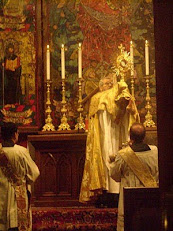Here in the Church of England, a very large percentage of our churches is dedicated to our Lady under the simple and gracious title of St Mary the Virgin. Post-Irish-immigration RC churches tend to prefer to be our Lady of something-or-other or the something-or-other of our Lady. Which is why, Fr Allan Hawkins tells me, his Anglican Usage Catholic parish in Arlington, Texas, is sometimes misdescribed as "St Mary of the Virgin". The elegant Englishness of "St Mary the Virgin" was deliberately chosen by his congregation when, in the 1980s, they entered into full communion with the Holy See (they were previously St Bartholomew's). This process was equally simple and elegant: on Pentecost Sunday they celebrated their last Mass together as Anglicans; a fortnight later Father became a priest in good standing with the RC diocese of Fort Worth and St Mary's resumed its communal life of witness to the Catholic faith as that has been received by Catholic Anglicans...
Read the rest of Fr. Hunwicke's reflections on his visit to Fr. Hawkins in Arlington, Texas at his blog Liturgical Reflections.
Obituary of a very failed Pontificate
-
"Nun khre methusthen kai tina per bian ponen, epei de katthane
Mursilos."Such would have been the reaction of the unchristianised Greeks.
But for us, for t...
6 months ago














No comments:
Post a Comment